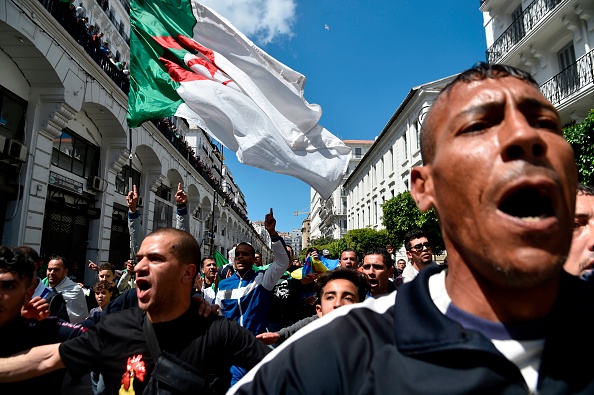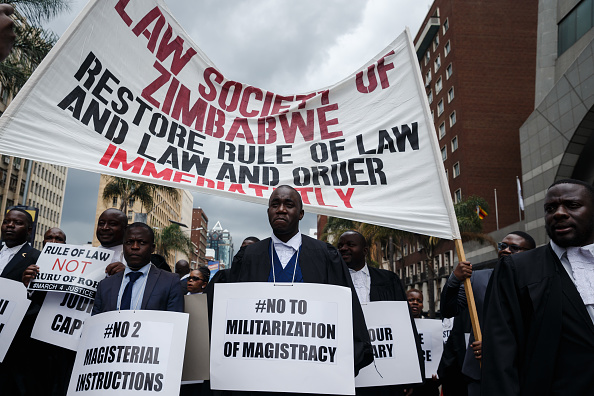A new tide of people power is rising in Africa. On April 2, a nonviolent resistance movement in Algeria succeeded in pressuring Abdelaziz Bouteflika to resign after 20 years as president. Nine days later, protesters in Sudan were celebrating the ouster of Omar al-Bashir, Sudan’s president of 30 years, after a three-month-long uprising against his regime.
The nonviolent overthrows of Bouteflika and Bashir are not aberrations. They reflect a surprising trend across the continent: despite common perceptions of Africa as wracked by violence and conflict, since 2000, most rebellions there have been unarmed and peaceful. Over the past decade, mass uprisings in Africa have accounted for one in three of the nonviolent campaigns aiming to topple dictatorships around the world. Africa has seen 25 new, nonviolent mass movements—almost twice as many as Asia, the next most active region with 16.
Since the 1970s, Africa’s nonviolent uprisings have also had the highest success rate in the world. Roughly 58 percent of the uprisings aimed at overthrowing dictatorships have succeeded, in countries as diverse as Burkina Faso, Côte d’Ivoire, Madagascar, Mali, South Africa, Tunisia, Zambia, and, most recently, Algeria and Sudan. That far surpasses the success rate of 44 percent for movements against autocratic regimes in all other regions.
What explains the striking effectiveness of African mass movements? One factor is Africa’s long legacy of resistance against colonial and neo-colonial rule. Mahatma Gandhi, after all, laid the foundations of his civil resistance to British rule in India over 21 years organizing with migrant workers in South Africa. Contemporary African resistance movements have deep roots, from anti-taxation campaigns waged in the early 1900s against British occupiers to coordinated actions to boycott apartheid-supporting businesses in 1990 South Africa. The movements in Algeria and Sudan occurred in many waves and echo past protests— in Algeria, the general strikes that occurred during the independence struggle, localized micro-riots, and national upheavals from 2010 to 2012; and in Sudan, the 1964 and 1985 uprisings. In addition to the historical knowledge that the current generation of protesters has inherited, four other key factors underpin the success of uprisings in Africa. Activists have mobilized mass movements, harnessed women’s participation and leadership, elicited active or tacit support from military and security services, and secured regional buy-in.
THE WINNING INGREDIENTS
For national movements to succeed, they must inspire mass participation that cuts across regional, generational, class, ethnic, and religious boundaries. African civil resistance has long relied on the leadership and coordinating power of professional associations, unions, and other institutions, such as churches, to communicate the principles of a movement to a wide range of participants. During Algeria’s recent uprising, a journalist and member of the book publishers’ association printed “18 commandments” for protesters to follow to ensure that the resistance remained nonviolent and effective. In Khartoum and Omdurman, the Sudanese Professionals Association brought together members of the health-care, education, and legal sectors under a nonideological banner. It also helped participants in the uprising maintain nonviolent discipline and speak with a unified voice. Protests in Zimbabwe against Robert Mugabe, one of Africa’s longest-serving presidents, had simmered for years, but they threatened the leader only when a charismatic pastor, Evan Mawarire, began mobilizing professionals and young people. These efforts animated over a year of protests by veterans, churchgoers, lawyers, the working poor, and others, ultimately toppling Mugabe in 2017.
During the past decade, mobilization has succeeded when activists have transcended their identities. With 62 percent of Africa’s population under the age of 25, successful coalitions have hinged on mobilizing youth support, as in Senegal’s Y’en a Marre movement (2011) and Burkina Faso’s Balai Citoyen (2013). In Algeria, young people have filled the streets protesting unemployment, but so, too, have their parents and grandparents, who want better futures for their children.

Underpinning these successes has been the prominent role of women organizing, leading, and joining resistance activities. As half of the population, women must participate if a mass movement is to work. But they have done more than simply show up: their leadership has added political legitimacy to protests, enhanced credibility to calls for nonpartisan unity, and reinforced the importance of nonviolent tactics. Iconic images from both Sudan and Algeria have featured young women dancing and reciting poetry, calling on demonstrators to celebrate and unite in the face of dictatorship. In Sudan, 22-year-old Alaa Salah, who was dubbed the protests’ “Nubian queen,” described her resistance as motivated by patriotism, not politics.
Women also joined Algeria’s protests on an unprecedented scale and held key leadership positions in the cross-party Citizen movement. Elsewhere on the continent, women have revitalized historically innovative tactics, such as deploying public nudity during environmental movements in Kenya, protesting for peace in Liberia and Sierra Leone, and pressuring Côte d’Ivoire’s former president to step down. In Zimbabwe, Women of Zimbabwe Arise had been organizing demonstrations against Robert Mugabe’s corruption and repression since the early 2000s, long before the protests that helped lead to his overthrow. And women have led efforts to meet protesters’ basic needs: take, for example, the grandmother in Khartoum who has coordinated volunteers to provide over 2,000 meals a day at the sit-in.
Protests, however large and inclusive, often struggle to elicit immediate change unless economic elites, civilian bureaucrats, and security forces stop protecting the status quo. For instance, security forces might signal non-cooperation with the regime by throwing down their arms, refusing to report for duty, ignoring orders to fire on demonstrators, or even defending protesters against repression. The Sudanese military, which was closely aligned with Bashir, chose to protect protesters in the streets of Khartoum from Janjaweed militias (the groups notorious for their role in the Darfur genocide) and other security forces, even as protesters occupied military headquarters. In this case, the military’s loyalty shifted from the bottom up: foot soldiers were siding with protesters on the street several days before top generals convened a midnight meeting to oust Bashir from office.
In Sudan, the opposition has continued massive protests and walkouts even after Bashir’s resignation and quickly announcing plans for a civilian transitional leadership council. Protesters in Algeria have applied similar pressure to their transition leaders and have turned their attention to perceived corruption in Bouteflika’s elite inner circle while they await details on civilian transition plans.

As protests persist and pressure mounts, regional actors play a bigger role in facilitating peaceful transitions and consolidating popular demands for democracy. The African Union (AU) champions democratic governance, but it has responded inconsistently to nonviolent resistance. The African Charter on Democracy, Elections and Governance, which came into force in 2012, rejects unconstitutional changes of government. This prevents the AU from explicitly endorsing popular protests as a legitimate basis for political transitions. As a result of this enforced neutrality, the AU failed in its attempt to intervene in the 2015 Burundi crisis owing to the controversial reelection of President Pierre Nkurunziza for a third term. The AU also sent mixed messages in the 2018 electoral protests in the Democratic Republic of the Congo and has turned a blind eye to ongoing protests in Cameroon as well as recent austerity protests in Chad.
Yet the African Charter on Democracy, Elections and Governance clearly spells out what should follow leadership changes induced by mass mobilization: a swift transition to democratic elections, with respect and protections for human rights. As a result, the AU has sided with the Algerian and Sudanese people in the aftermath of their movements’ victories, calling for civilian-led transitions to democratic rule in both countries. This recent shift toward unequivocal support for civilian rule from the AU is significant because it signals consolidation of democratic norms on the continent, even (perhaps especially) without U.S. and European interventions to that end.
Subregional groups have been even more influential than the AU in consolidating political gains achieved through nonviolent resistance. Mass protests in Côte d’Ivoire in 2011, Burkina Faso in 2014, and The Gambia in 2016 initiated political transitions partly because of mediation by the leaders of the Economic Community of West African States. Key allies and institutions that prop up autocrats can also play a decisive role by withdrawing their support. For instance, the Southern Africa Development Community’s decision not to defend Mugabe during the protests was crucial for the political transition in Zimbabwe.
POWER TO THE PEOPLE
Civil resistance campaigns in Africa don’t always succeed. Recent pro-democracy movements in Cameroon and Togo have so far led only to violent government crackdowns. And even when civil resistance works in the short term, the new system sometimes falls short of delivering real change. In South Africa, for example, many observers complain that although legal apartheid ended in 1994, inequality, segregation, and racism persist.
Yet the historical record provides reason for cautious optimism. In Africa more than anywhere else in the world, civil resistance campaigns outperform armed struggle. And nonviolent movements generally lead to higher-quality democracies in the long term. International actors and regional organizations, such as the African Union and its nine constituent subregional communities, have an important role to play in denouncing the repression of peaceful protesters, protecting democratic institutions and human rights, and helping consolidate transitions to democracy. External actors should not subvert or co-opt popular protests—but they can support their aspirations for democracy and respect for human rights.
*ZOE MARKS is a Lecturer in Public Policy at the Harvard Kennedy School and member of the Harvard Center for African Studies Executive Committee.
*JIDE OKEKE is a Mason Fellow at the Harvard Kennedy School.
*ERICA CHENOWETH is Professor of Public Policy at the Harvard Kennedy School and a Susan S. and Kenneth L. Wallach Professor at the Radcliffe Institute for Advanced Study.
This article was originally published on ForeignAffairs.com.









